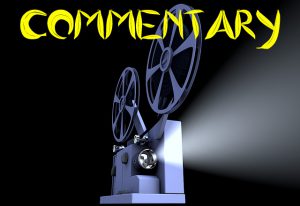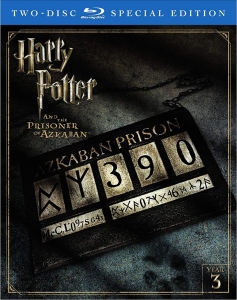My series looking back at the “Harry Potter” films continues with Year 3, “Harry Potter and the Prisoner of Azkaban” (2004):
WHY IT’S GREAT
Alfonso Cuaron would later write and direct the dystopian sci-fi classic “Children of Men” (2006), so in retrospect, it’s no surprise that he brings a spot-on sensibility to “Prisoner of Azkaban.” J.K. Rowling’s book is thematically about the line at which society’s supposed protectors become its oppressors, and Cuaron – working from an assured Steve Kloves script – emphases that even more.
The first two acts are a beautifully dark pastiche of imagery more so than a story; consider the Quidditch match, which is entirely about the Dementors attacking Harry, not at all about Gryffindor’s loss to Hufflepuff. When the executioner (seemingly) beheads Buckbeak, it’s framed like the execution of the resistor in “Children of Men” – from a distance. Additionally, there are crows all over the place, and John Williams delivers his least Williams-esque score, building off of a children’s chorus singing “Macbeth’s” “Double Trouble.”
WHY IT’S NOT SO GREAT
There’s little to complain about here, but I’d like to point out a scene for discussion: The showdown in the Shrieking Shack. On one hand, it’s brilliant how (on first read) we (and our hero trio) don’t know the loyalties of Sirius, Lupin or Snape – plus Scabbers is a bizarre wild card. But it bugs me how long it takes for that chapter to get to the point. Similarly, in the movie, Sirius keeps saying “Let’s just kill him!” but takes forever to make it clear he’s talking about Scabbers/Pettigrew, and that our young heroes need not fear him. It makes for a jittery scene.
BEST YOUNG CHARACTER AND ACTOR
Hermione (Emma Watson). It’s impossible for anyone other than Harry to be the central figure, since we aren’t privy to anything he’s not privy to. However, Rowling allows Hermione to come into her own in “Azkaban,” as the adults trust her with a Time-Turner so she can take extra classes, and Dumbledore ultimately lets her use it to save the lives of Sirius and Buckbeak. She pulls Harry along for the ride. Perhaps divinely, perhaps naturally, Watson is totally comfortable in the role here, having come a long way since the first film.
BEST ADULT CHARACTER AND ACTOR
Remus Lupin (David Thewlis). Rowling pushed the idea that Sirius is Harry’s closest father figure, but on film, it seems like Lupin has that distinction – at least at this point. He’s a great teacher to Harry, giving personalized lessons from basic Riddikulus spells to the conjuring of a Patronus. I like how he says Harry is wise for fearing fear itself, an interesting twist on the FDR quote. And frankly, after watching Thewlis as the slimy villain in “Fargo” Season 3, it’s a breath of fresh air to see him playing a decent fellow.
BEST MOVIE MAGIC
Buckbeak. Wonderfully imagined by Rowling, this Hippogriff – part-horse, part-eagle – interacts with the humans better than most real animals do, and we share the kids’ desire to save his life. Especially when in flight, the creature symbolizes the freedom being snuffed out of our heroes’ lives (the titular Sirius being the most literal victim).

BEST COMEDIC BIT
“Prisoner of Azkaban” is not a comedic movie, but the most “let your breath out and laugh” moment is when Hermione punches a completely asking-for-it Malfoy in the nose. She says “That felt good,” and Ron adds: “Good? That was brilliant!” It’s a bit teed up, as Malfoy had shown hints of depth in “Chamber of Secrets,” and he’s a one-note sniveler here. But it’s a bluntly satisfying moment that shows us Hermione, who was petrified (literally) during the climax of the previous film, is now a character of agency.
BEST DRAMATIC BIT
The time-travel sequence at the end is delicious. It avoids deus ex machina status thanks to the peppered-in moments of Hermione suddenly popping up in class: It turns out she was time-traveling all along. It’s thrilling to see Harry and Hermione avoiding “themselves” and fun to see the occasional little joke such as Hermione seeing what her hair looks like from behind. It’s capped by Harry saying he had the confidence to produce a Patronus because he had already seen himself do it, which makes no sense to Hermione, thus allowing us to feel OK about not wrapping our heads around it either.
WHERE IT RANKS
“Azkaban” challenges the notion that faithful book adaptations are inevitably going to be stiff. It flows wonderfully and Cuaron teases out the (unfortunately) timeless protectors-become-oppressors theme through the Dementors without being heavy-handed. Every scene is rich with detail (note the swaying of the Shrieking Shack), even though, in terms of the story, Cuaron and Kloves eschew many details. Yet we don’t feel like Rowling’s work got chopped up. The film is both an adaptation and a love-letter to the source material, dripping with style that’s absent from the first two movies.
Book review: “Prisoner of Azkaban”
Next movie: “Goblet of Fire”

